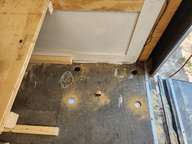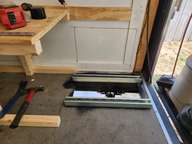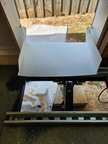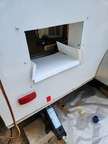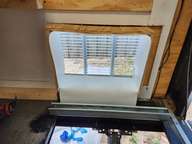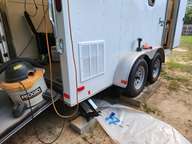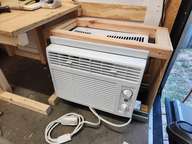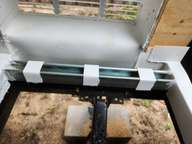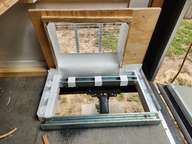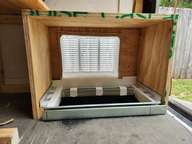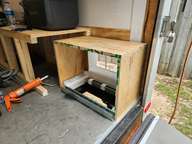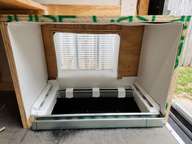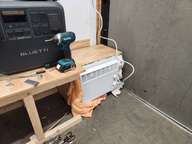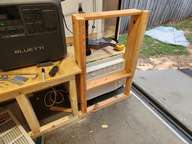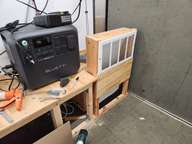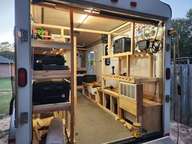Run Home to Mama: The Bug Pages
I Did It My Way
We are spoiled. All of us. Anyone born into the world of air conditioned summers is spoiled by that experience. We just don't want to even imagine life without that cooling hardware.
The Problem
Have you priced RV air conditioners? I did and nearly choked. $1,200.00 for one of the roof-mounted units. No. Not doing that. I'll find another way.
The only real alternative is a window unit. We've all seen campers with window units sticking out the side and it is a look I really wanted to avoid. There are certain design challenges to using a window unit in a camper. That's exactly why you see them sticking out the backs of trailers, dangling precipitously with copious amounts of sealer all around their periphery. I can't do that.
The Unit
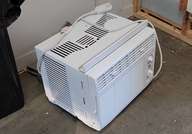
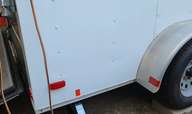 This is perhaps the most basic 5000 BTU window unit you can buy. It is branded GE and cost $150.00 at Home Depot. The controls are all analog, which is perfect. I bought it. This is what I'm going to use. And this is where I want to put it.
This is perhaps the most basic 5000 BTU window unit you can buy. It is branded GE and cost $150.00 at Home Depot. The controls are all analog, which is perfect. I bought it. This is what I'm going to use. And this is where I want to put it.
More Problems: Design Challenges
I started listing out the issues related to using this window unit in The Bug.
- get the hot air to go out and keep the cold air in
- keep the inevitable condensate water out of the trailer
- compensate for vibration and bouncing during transit
- make it look like there is not a window unit in the trailer
One by one I addressed those issues.
- I would need to build a baffle system around the exterior of the unit to isolate the back end from the front.
- The back end would need to be able to pull fresh air in the sides and top, and exhaust the hot air out the back.
To accomplish that, I decided I would vent the condenser (the back coil) out the side of the trailer. Fresh air would have to come from somewhere, so I would need some sort of ducting from that source to the sides and top of the unit.
- Condensate water is a important part of a window unit's design. Moisture in the air condenses on the evaporator (front) coil. That water then runs down and collects in the bottom of the unit where gravity moves it to the lowest spot in the rear of the unit.
Windows units rely on that water to enhance their efficiency. They sling it into the condenser (rear) coil for additional cooling. The pan that is the bottom of the unit is intended to allow condensate to pool, so it needs to remain almost level.
One side effect of this system is some of that condensate water gets slung out the sides of the unit. That water has to go somewhere. A second side effect is under extremely humid conditions more condensate is created than is used. The condensate pan fills and overflows. In a normally-installed window unit, that's not a problem. It is a problem I have to address in this install.
The condensate issue and the fresh air issue complemented each other. The solution to both was to suspend the unit above a hole in the floor of the trailer.
So, after much anxious measuring and contemplation, I cut a hole in the floor and mounted two pieces of unistrut above it.
Next, I cut a hole in the side of the trailer, lined it with left-over PVC wall-sheet from the shower install.
I then set about piecing together the baffles and shroud needed to get the air to go where I wanted.
Take a stroll through the Gallery. Pay attention to the captions, then we'll continue.
This is a Good Place for The A/C Gallery
Key Points
- Design must allow for simple service. I hope I don't have to do any service, but if I do, it should be easy to access what needs fixing.
- We need to keep outside out and inside in.
- We don't want unexpected insect guests.
- We must allow for maximum air-flow in order to avoid hurting the unit's efficiency. Reducing airflow with things like screen wire will make the unit perform poorly. (Typical window screen can reduce airflow as much as 50%.)
- I was able to design a clip that bolts the front of the unit to the unistrut. This keeps it from moving during transit.
I bought an analog thermostat from Home Depot. I modified it so I could use one set of its contacts to control 12VDC to a relay. The relay then controls the 120VAC to an outlet. The airconditioner is plugged into that outlet. I leave the controls on the front of the unit on high all the time with its internal thermostat set to maximum. My modified thermostat then controls the unit.
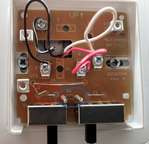 My mods to the thermostat were cutting a jumper (red circle) and lopping off a resistor (blue circle). One pair of wires is for the "Cool/Off" switch, the other is the contacts on the bi-metal spring.
My mods to the thermostat were cutting a jumper (red circle) and lopping off a resistor (blue circle). One pair of wires is for the "Cool/Off" switch, the other is the contacts on the bi-metal spring.
In the end, this whole thing turned out very nice, and cools the trailer quite well. I use a small fan to circulate the air in the trailer, which enhances the effectiveness of the whole thing. I'm happy.
Air conditioning that looks nice and doesn't break the bank. That is a thing that works.
